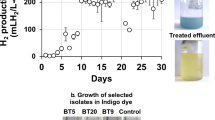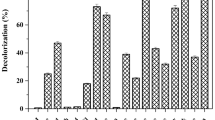Abstract
In the present study, a consortium of Cardiobacterium hominis and Pseudomonas stutzeri was isolated from an effluent treatment plant of a textile industry, based on its ability to decolourise azo dyes including direct black 38 (DB38), a benzidine-based azo dye. The role of each culture in the decolourisation process was elucidated, and C. hominis was found to decolourise the dye. Although P. stutzeri could not decolourise the dye, it was found to synergistically enhance dye decolourisation activity of C. hominis by scavenging oxygen in the medium and creating an anaerobic condition (oxidation/reduction potential −440 mV), which is known to be necessary for azo dye decolourisation. Together, the cultures could decolourise 90.5% of 100 mg l−1 DB38 within 24 h. Kinetics of DB38 decolourisation was also examined, and P. stutzeri was found to increase V max and K m of decolourisation activity of C. hominis by 3.6- and 3-fold, respectively. The study also revealed a pathway of DB38 degradation with the release of benzidine from DB38 and subsequent degradation of benzidine to 4-aminobiphenyl by the cultures.







Similar content being viewed by others
References
Brahimi-Horn MC, Lim Liany SL, Mou DG (1992) Binding of textile azo dyes by Mirothecium verrucaria Orange II, 10B (blue) and RS (red) azo dye uptake for textile wastewater decolorization. J Ind Microbiol 10:245–261
Chen H (2006) Recent advances in azo dye degrading enzyme research. Curr Protein Pept Sci 7:101–111
Chung KT, Stevens SEJ (1993) Degradation of azo dyes by environmental microorganisms and helminths. Environ Toxicol Chem 12:2121–2132
Cooper P (1993) Removing colour from dyehouse waste waters—a critical review of technology available. J Soc Dyers Colour 109:97–100
Coughlin MF, Kinkle BK, Bishop PL (1999) Degradation of azo dyes containing aminonaphthol by Sphingomonas sp. strain 1CX. J Ind Microbiol Biotech 23:341–346
Fang H, Wenrong H, Yuezhong L (2004) Biodegradation mechanisms and kinetics of azo dye 4BS by a microbial consortium. Chemosphere 57:293–301
Field JA, Stams AJM, Kato M, Schraa G (1995) Enhanced biodegradation of aromatic pollutants in cocultures of anaerobic and aerobic bacterial consortia. Antonie van Leeuwenhoek 67:47–77
Hu T-L (2001) Kinetics of azoreductase and assessment of toxicity of metabolic products from azo dyes by Pseudomonas luteola. Water Sci Technol 43:261–269
Isik M, Sponza DT (2004) Monitoring of toxicity and intermediates of C.I. Direct Black 38 azo dye through decolorization in an anaerobic/aerobic sequential reactor system. J Hazard Mater 114:29–39
Kumar K, Devi S, Krishnamurthi K, Gampawar S, Mishra N, Pandya G, Chakrabarti T (2006) Decolorisation, biodegradation and detoxification of benzidine based azo dye. Bioresour Technol 97:407–413
Manning BW, Cerniglia CE, Federle WW (1985) Metabolism of the benzidine-based azo dye Direct Black 38 by human intestinal microbiota. Appl Environ Microbiol 50:10–15
Melgoza RM, Cruz A, Buitrón G (2004) Anaerobic/aerobic treatment of colorants present in textile effluents. Water Sci Technol 50:149–155
Pinheiro HM, Touraud E, Thomas O (2004) Aromatic amines from azo dye reduction: status review with emphasis on direct UV spectrophotometric detection in textile industry wastewaters. Dyes Pigm 61:121–139
Polman JK, Breckenridge CR (1996) Biomass-mediated binding and recovery of textile dyes from waste effluents. Text Chem Color 28:31–35
Robinson T, McMullan G, Marchant R, Nigam P (2001) Remediation of dyes in textile effluent: a critical review on current treatment technologies with a proposed alternative. Bioresour Technol 77:247–255
Sumathi S, Phatak V (1999) Fungal treatment of bagasse based pulp and paper mill wastes. Environ Technol 19:93–98
Vandevivere PC, Bianchi R, Verstraete W (1998) Treatment and reuse of wastewater from the textile wet-processing industry: review of emerging technologies. J Chem Technol Biotechnol 72:289–302
Weisburger JH (2002) Comments on the history and importance of aromatic and heterocyclic amines in public health. Mutat Res 506–507:9–20
Zollinger H (1987) Colour chemistry-synthesis, properties and applications of organic dyes and pigments. VCH Publishers, New York, pp 92–100
Acknowledgement
Amit Bafana gratefully acknowledges the Council of Scientific and Industrial Research (CSIR), New Delhi for the award of Shyama Prasad Mukherjee (SPM) Fellowship.
Author information
Authors and Affiliations
Corresponding author
Rights and permissions
About this article
Cite this article
Bafana, A., Devi, S., Krishnamurthi, K. et al. Kinetics of decolourisation and biotransformation of direct black 38 by C. hominis and P. stutzeri . Appl Microbiol Biotechnol 74, 1145–1152 (2007). https://doi.org/10.1007/s00253-006-0751-5
Received:
Revised:
Accepted:
Published:
Issue Date:
DOI: https://doi.org/10.1007/s00253-006-0751-5




